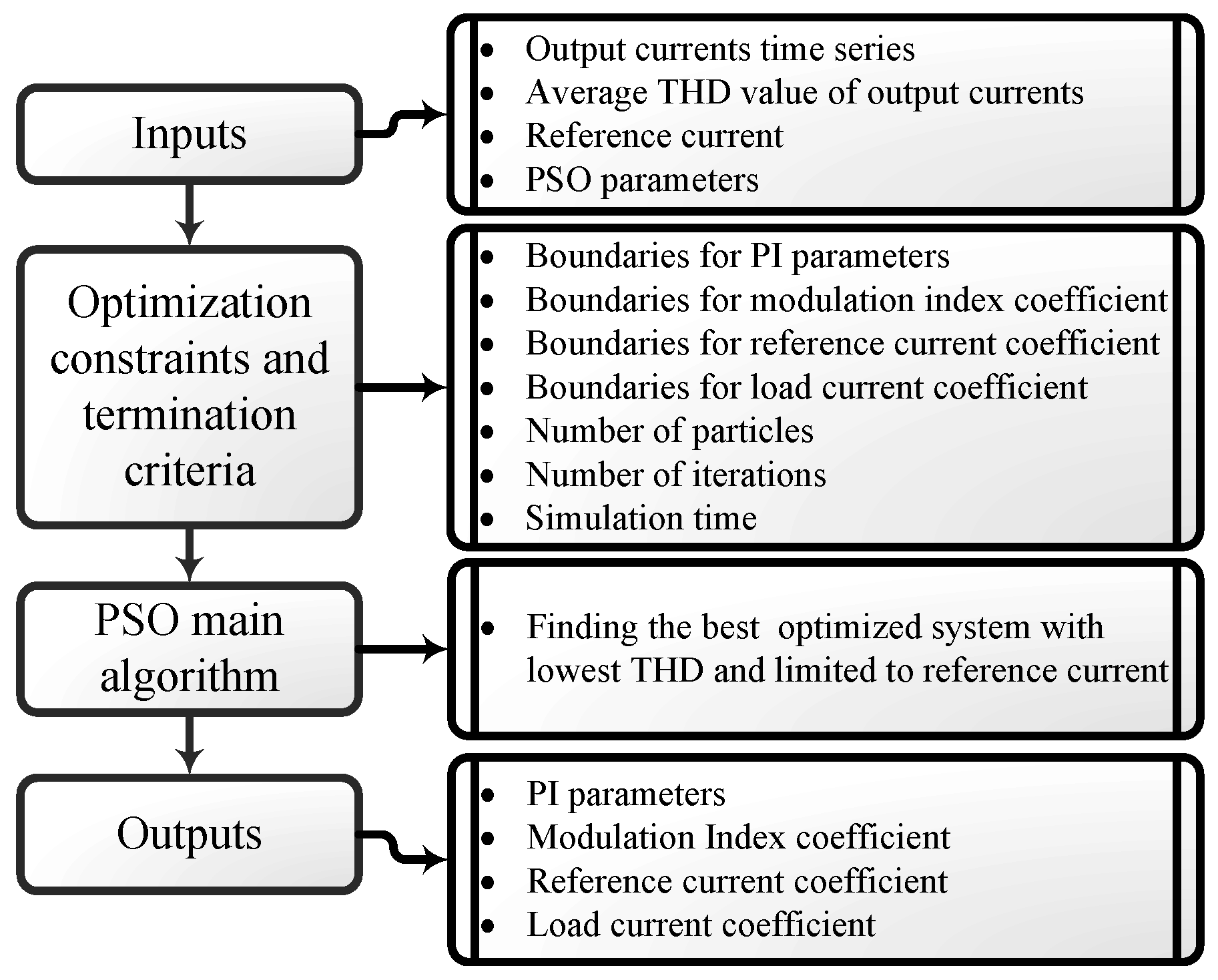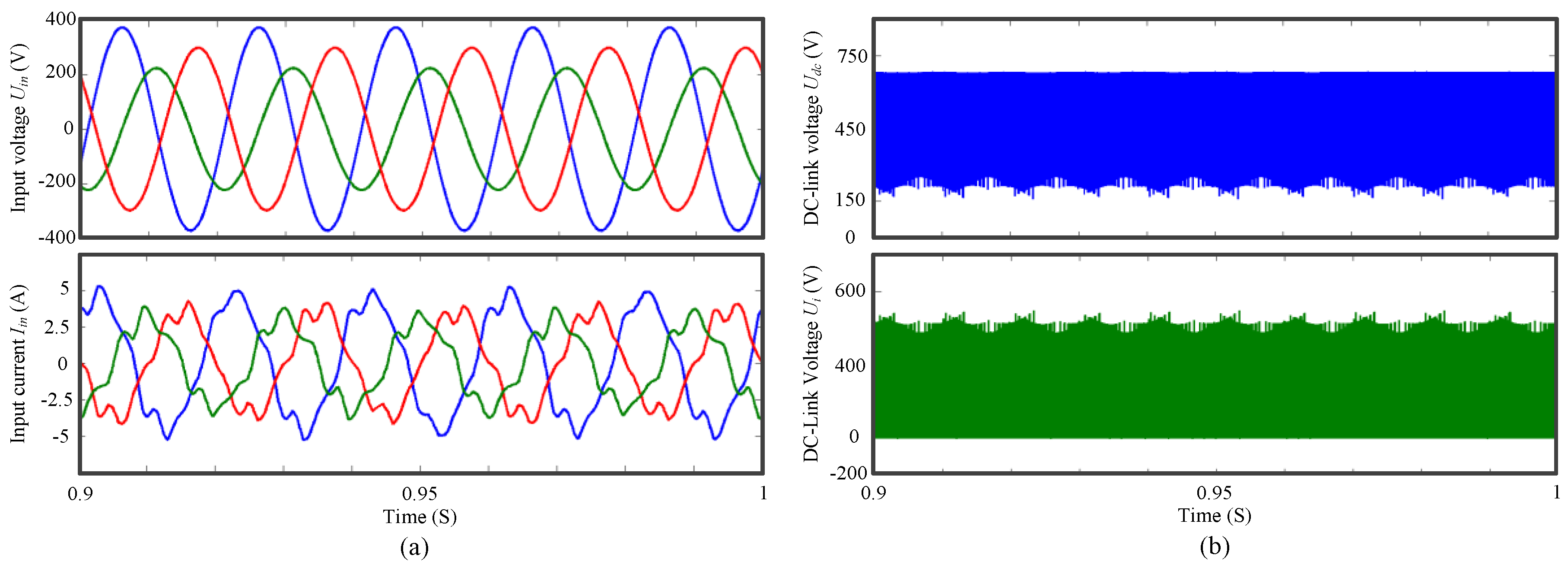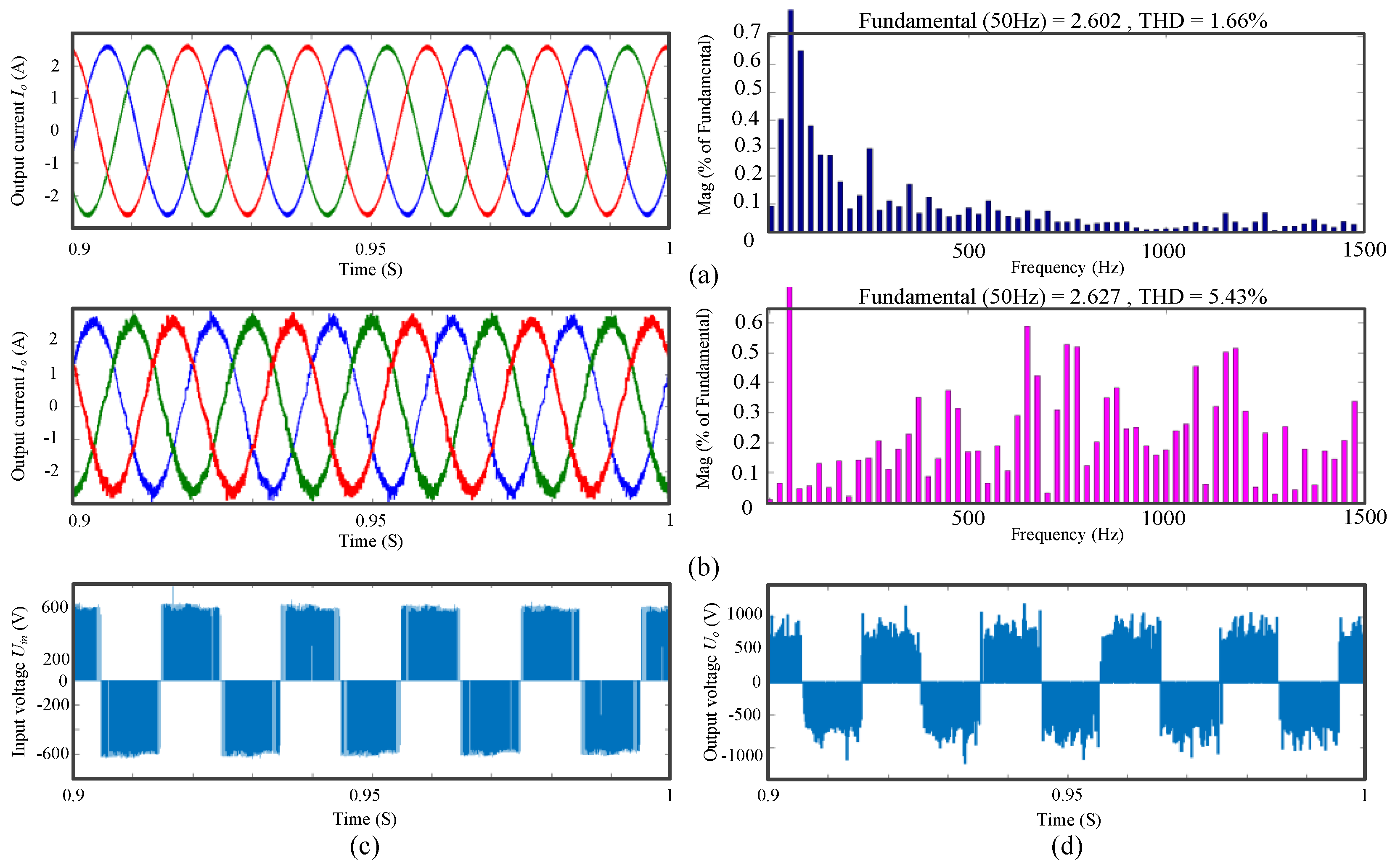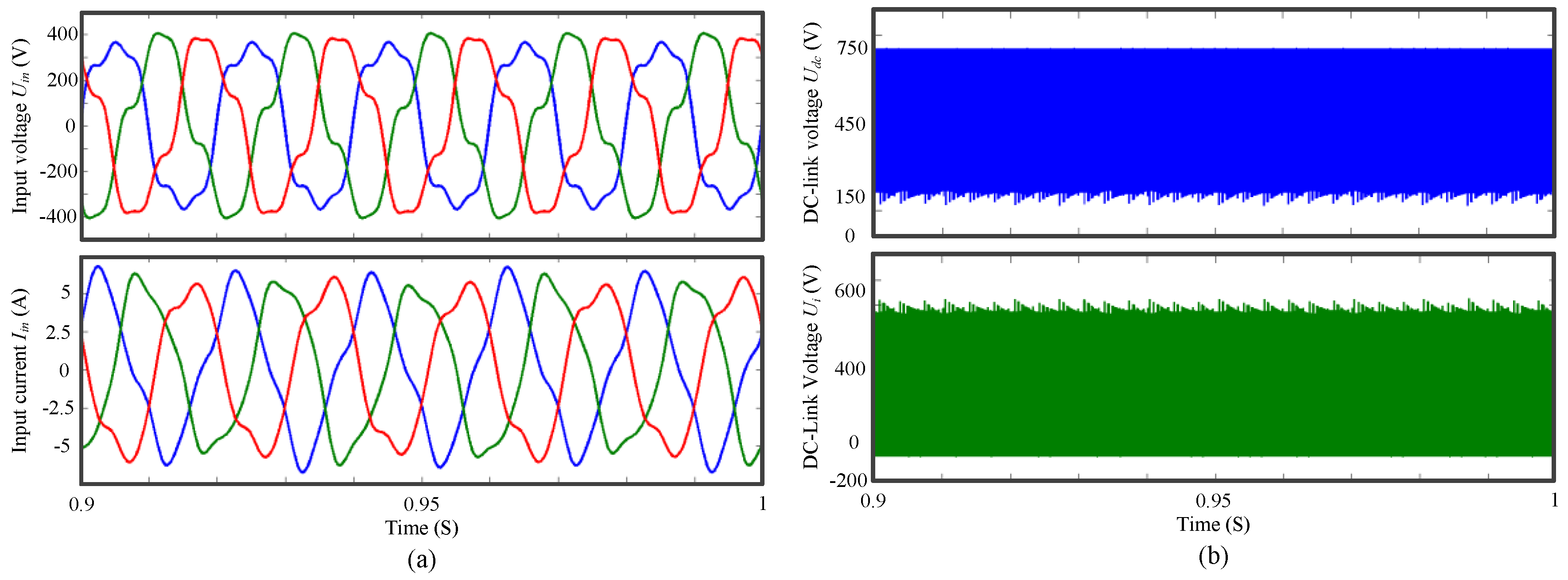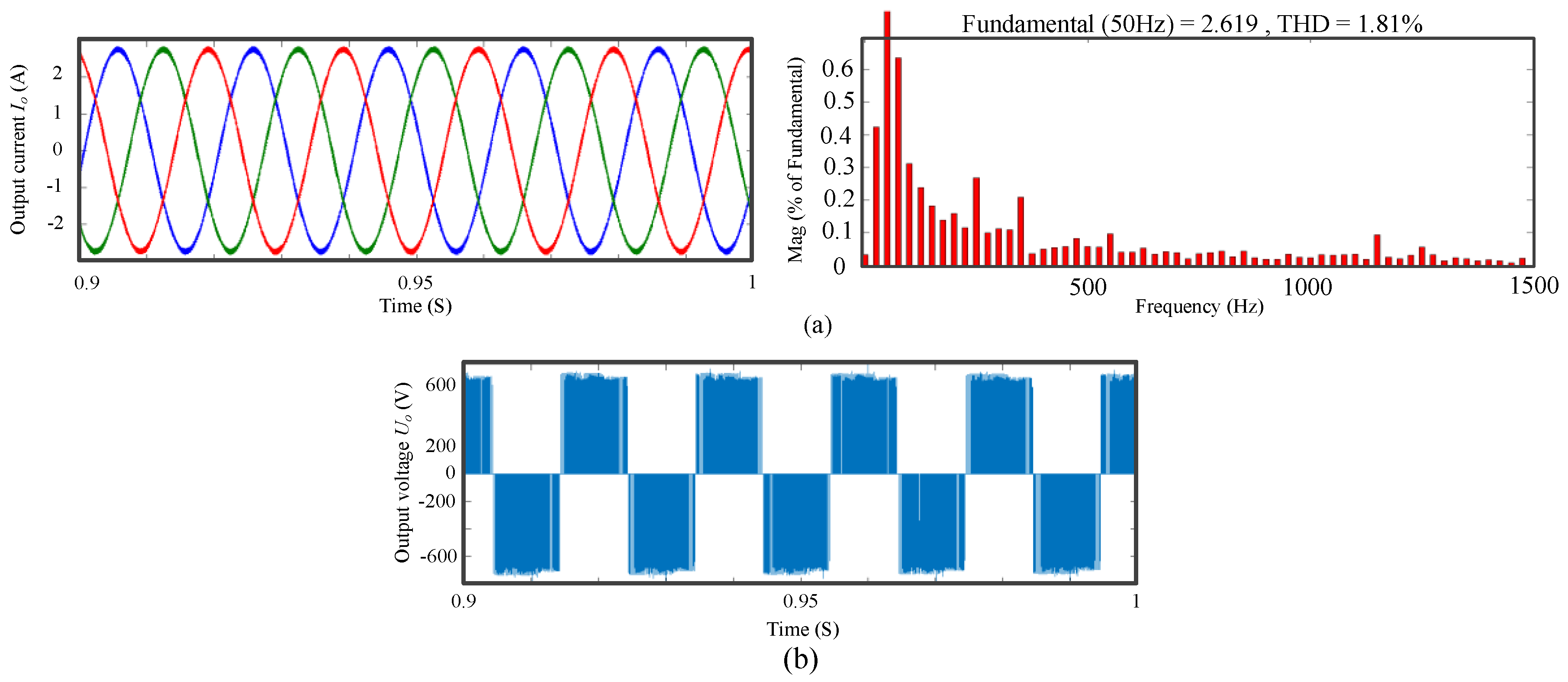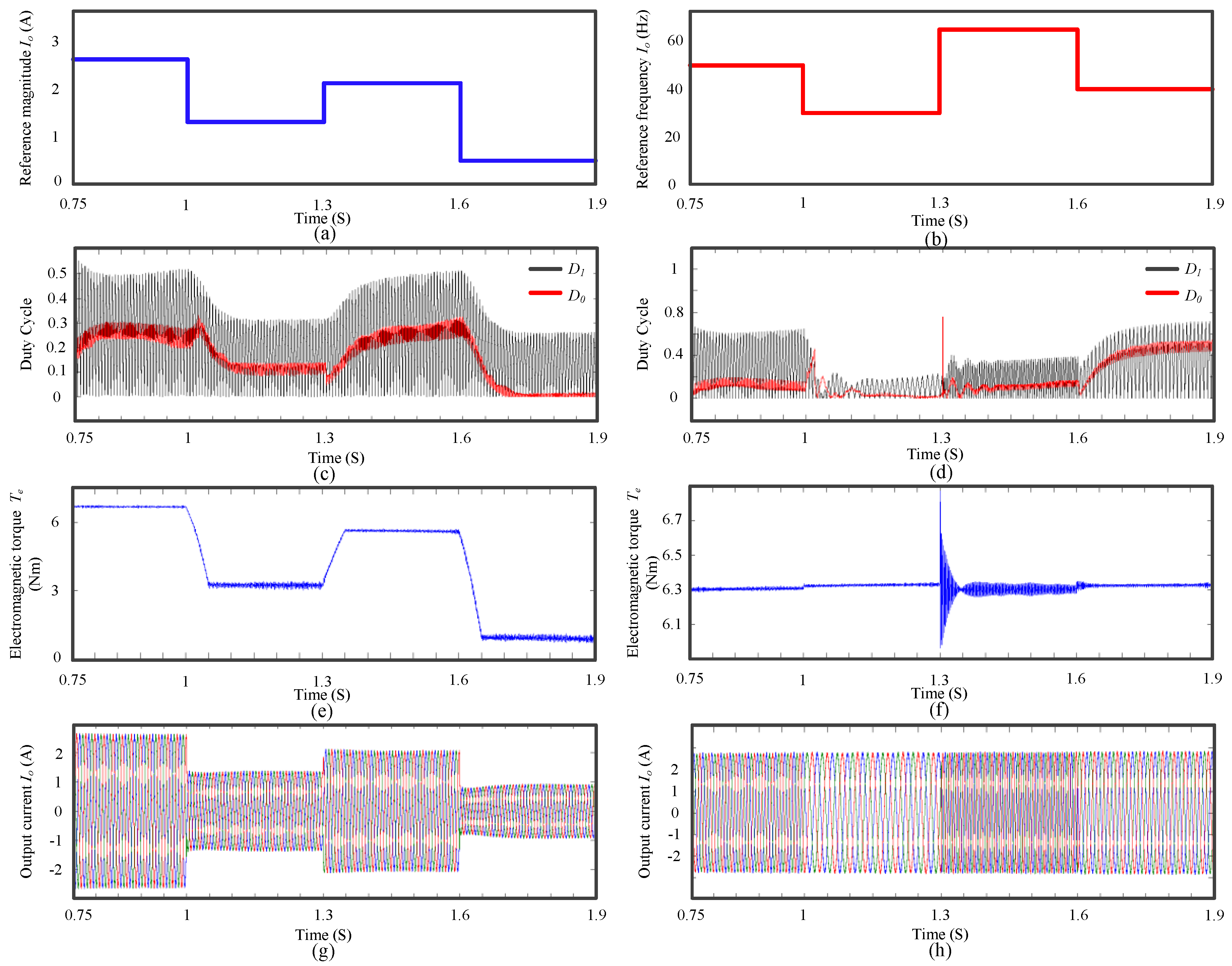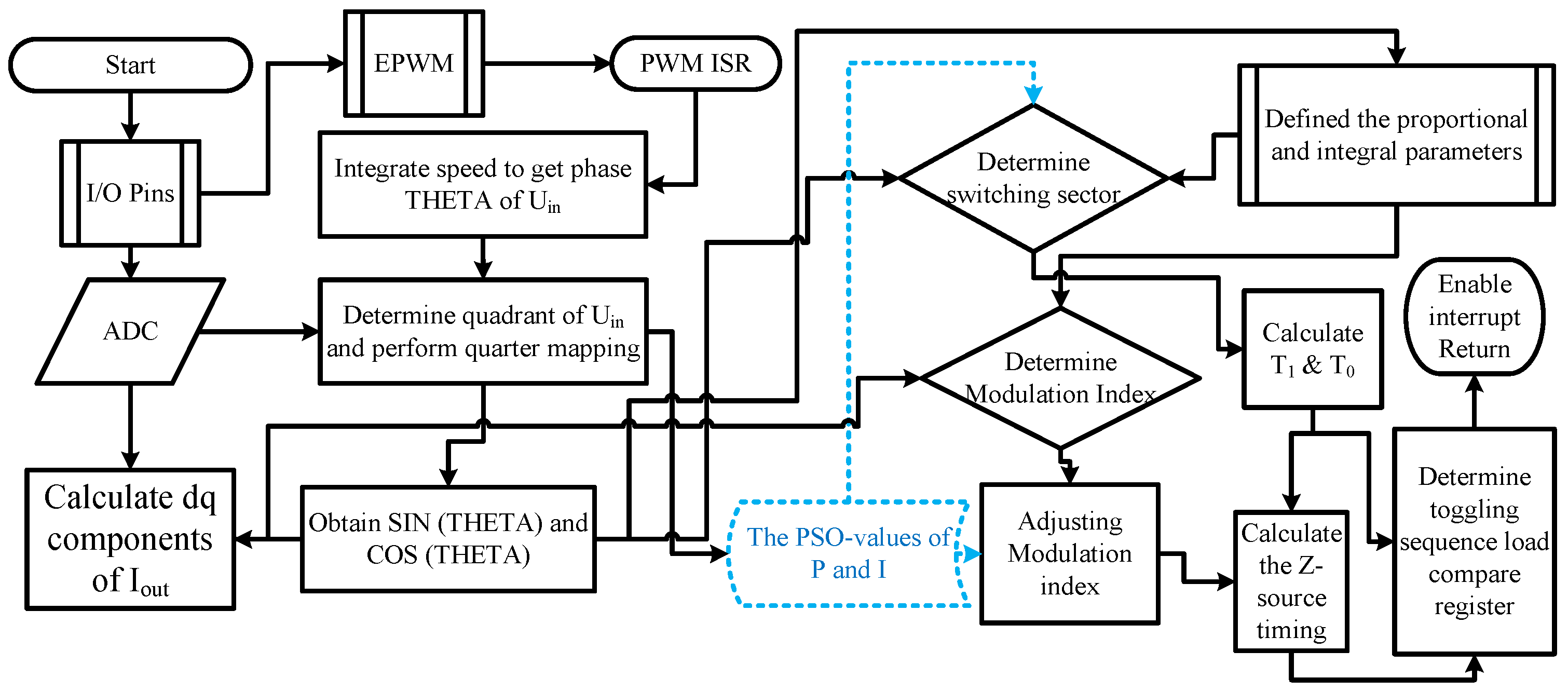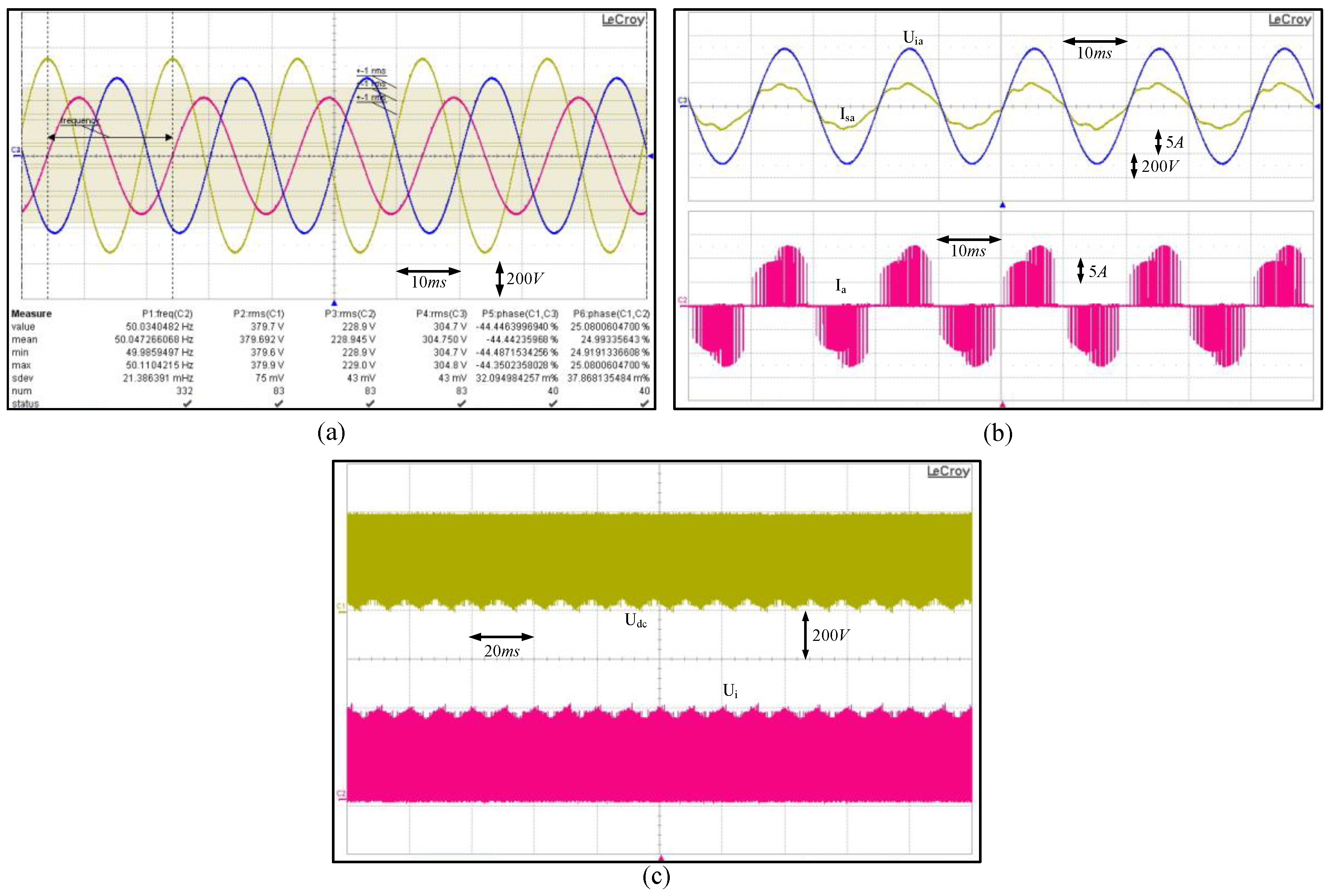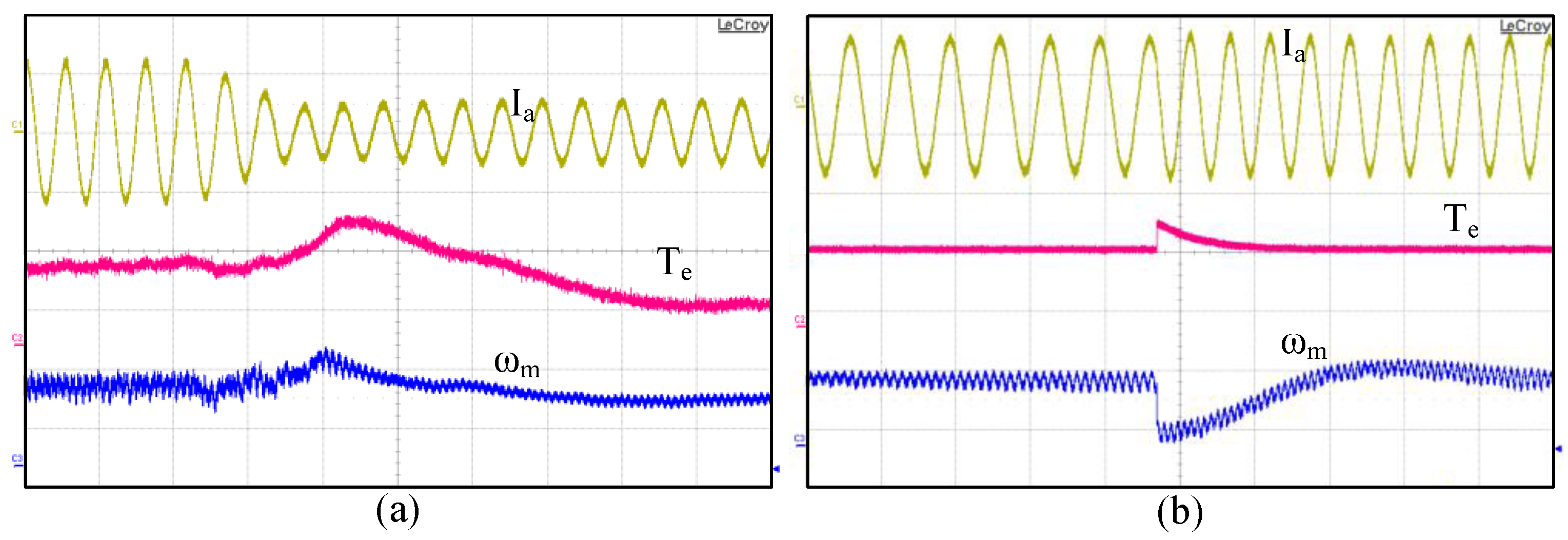1. Introduction
In traditional converters, a two-stage AC/DC/AC system is used to convert the input AC voltage and current to a variable amplitude and/or a variable frequency. Such instrumentation requires bulky DC-link storage such as electrolytic capacitors [
1]. Removing bulky capacitor results in compact converters [
1,
2], and coupling both sides of the converter to switches results in a high power density for the matrix converter (MC) [
3]. Regardless of the load, such a structure also provides reliable input power factor correction by implementing proper modulation [
4,
5].
The MC family is still categorized as a laboratory AC/DC driver with little reliable potential for industrial use [
6,
7] because of the control complexity [
8], sensitivity in the face of abnormal input [
9], limitation of the voltage transfer ratio up to 86.6% [
10], and excess semiconductor switches [
11]. These are the most critical obstacles to overcome, and, hence, solutions would be welcomed by manufacturers and industrial developers. Furthermore, a direct matrix converter has a flow power path in the bidirectional mode for transmitting the power [
10], either from the grid to the load or, it can be reversed in the generative mode. The bidirectional capability is an advantage for various applications [
12]; nevertheless, in the aerospace industry, where the power flow must be in one direction, it counts as a drawback [
13]. Although eliminating the bulky DC-link is an inherent specification of MCs, the excessive number of switches for the conventional topology increases the weight, which makes it unsuitable for aerospace manufacturing [
13,
14]. Connecting the MC to an unbalanced grid has an effect on the controlling system, which has been discussed extensively for the MC under abnormal input supply conditions [
9].
Unbalanced voltage supply can result in distorting input/output harmonic currents, and consequently, can affect the induction motor (IM) driving. Normally, the IMs are not able to operate under abnormal supply conditions [
15]. The unbalanced voltage increases the rotor losses, which results in both rotor and stator temperature rises that can cause serious damage to the three phase IM, such as decreased electromagnetic-torque, and increased heat and vibration. This affects machine insulation life [
16]. Several published investigations have reported ways to decrease the unwanted effects of abnormal voltage supplies [
9,
17]. A feed-forward compensation strategy is presented in [
18], which could achieved balanced output currents under abnormal conditions by adapting the voltage modulation index. Furthermore, two modulation methods of input current for the MC are provided in [
19], and their input and output performance were also analyzed under the unbalanced input and output conditions.
The computational optimization methods using bio-inspired technologies have been significantly developed in recent years. They can effectively increase the efficiency of systems. References [
20,
21] studied optimization of switching state, using Crazy- particle swarm optimization and real-time PSOIOC in order to predict the next switching state in, and the output can help control the state of switches in the matrix converter.
This paper proposes a novel driving strategy for an IM fed by an ultra-sparse Z-source MC, which can boost the voltage transfer ratio up to unity by using an X-shape Z-source network with small size components. It functions under unbalanced and distorted input voltage conditions while minimizing the total harmonic distortion (THD) of the output current through the Particle Swarm Optimization-PI (PSO-PI) control scheme. The PI parameters of the feedback/feedforward controller can be tuned by various methods such as Ziegler–Nichols (ZN) but the internal impact of other elements and the PI parameters cannot be simultaneously reflected. In this paper, the THD of the output current has been monitored and the proportional and integral parameters of controllers are optimized in the
d-q scheme by using a PSO method while the inter-correlations of the other elements and the PI parameters is considered together. These capacities may make the matrix converter suitable for industries that require high reliability, in particular aerospace manufacturing [
11,
22].
2. Z-Source and Voltage Transfer Ratio
The Ultra Sparse Matrix Converter (USMC) is a kind of indirect matrix converter (IMC) with a low-complexity modulation scheme compared with the conventional IMC. It only requires nine semiconductor switches—three switches in the rectification part and the remaining six used in the inversion part. This topology could provide all the desired characteristics that a common matrix converter would, except power flow bi-directionality. The Z-source network operates simultaneously as an energy reservoir and a filter to overcome the current and voltage ripple [
7], as depicted in
Figure 1.
The indirect energy conversion (such as matrix converter) requires more semiconductor devices than a conventional AC/AC indirect power frequency converter, since no monolithic bi-directional switches exist and consequently, discrete unidirectional devices, variously arranged, have to be used for each bi-directional switch. Finally, it is particularly sensitive to disturbances of the input voltage system.
There is an alternative option of indirect energy conversion by employing IMC or the sparse matrix converter. The (very/ultra) sparse matrix converter is an AC/AC converter which offers a reduced number of components, a low-complexity modulation scheme, and low realization effort. Sparse matrix converters avoid the multi-step computation procedure of the conventional matrix converter, improving system reliability in industrial operations. Their principal application is in highly compact integrated AC drives. The characteristics of the sparse matrix converter are the following:
- (1)
Quasi-Direct AC/AC conversion with no DC-link energy storage elements.
- (2)
Sinusoidal input current in phase with mains voltage.
- (3)
Zero DC-link current commutation scheme resulting in lower modulation complexity and very high reliability.
- (4)
Low complexity of power circuit/power modules available.
- (5)
The ultra-sparse matrix converter shows extremely low realization effort, in case unidirectional power flow can be accepted (admissible displacement of 30° the input current fundamental and input voltage, as well as for the output voltage fundamental and output current), accordingly, a possible application area would be variable speed permanent-magnet synchronous motor (PMSM) or IM drives with low dynamics.
As with the DC-link based Voltage Source Inverter (VSI) and Current Source Inverter (CSI) controllers’ separate stages are provided for voltage and current conversion, but the DC-link has no intermediate storage element. Generally, by employing matrix converters, the storage element in the DC-link is eliminated from the cost of a larger number of semiconductors. Matrix converters are often seen as a future concept for variable-speed drive technology, but despite intensive research over the decades, they have until now, only achieved low industrial penetration. However, citing the recent availability of low-cost, high-performance semiconductors, at least one larger drive manufacturer has been actively promoting matrix converters over the past few years.
Moreover, the Z-source converter has two operating modes in this study: DC/AC inversion and AC/DC rectification. Circuit analysis for both operating modes shows that the new topology does not impose critical conflicts in circuit design or extra parameterization restrictions. On the contrary, one version of the proposed zero current (ZC) can take full advantage of Z-source network components in both operating modes, i.e., a pair of Z-source inductor and capacitor can be used as the low-pass filter in AC/DC rectification.
The Z-source Inverter (ZSI) works primarily in two distinctive functioning modes: first across the normal operating mode or non-shoot-through state, where the accumulated power is applied into a corporate output voltage. Supposedly, a steady DC-link voltage delivers the ZSI within a switching period. In
Figure 2a, a current source as the output of the Z-source system demonstrates a limited current flow, while
Figure 2b under the same input DC voltage is an open circuit. Meanwhile, in
Figure 2c the output of the Z-source network is shorted where the high current flows through the circuit, and, simultaneously, the -DC supply for the network is zero. In the shoot-through state, the Z-source network stores the inductive and capacitive power with its elements. The third approach occurs when two switches from the same leg of the inverter are ON.
According to [
23], the timing of the shoot-through and non-shoot-through state mode are defined by
T0 and
T1. If we suppose
UL is constant in their interval integration, the current variation in the shoot-through and non-shoot-through mode can be extracted as Equation (1):
On the other hand, the switching period is assumed to be
T, where
T0 +
T1 =
T, and, during the switching period in the steady state mode, the average voltage of the inductor is moderated by keeping close to zero; hence, we have:
During the non-shoot-through state, when
T1 is greater than or equal to
T0, the voltage
Ui across the inverter bridges can be expanded:
The time-based boost factor (
BFt) is determined in Equation (4). On the other hand, based on the symmetrical properties of the Z-source network, we not only have the same equations for current but also the ratio for the inductive to capacitive current of Z-source has been kept load dependent, as can be seen in Equation (5):
where
Z has been assumed to be the equivalent load of the connected IM rear-end Z-source inverter in complex frequency (S-domain). Therefore, with the same strategy for the conjugate properties of voltage, expectations can be extracted by Equation (6):
In contrast, the boost factor that is normally defined by
Ui/
Udc which is independent of the Z-source output and consequently from input grid power and dependent on induction motor elements as shown in Equation (8):
Two approaches are plausible to increase the boost factor ratio. First, by increasing
T0 to near
T1 based on Equation (4); second, determining
L and
C values in the way that the poles are drawn to zero based on Equation (8).
T0 determine the
L and
C, Equation (8) should be plotted. This curve,
Figure 3a, represents the relation between the Z-source element (
L and
C) and voltage transfer ratio, while
Z is replaced with the value of the IM parameters detailed in
Table 1. The expansion of
Z in a persistent sinusoidal component (sin(
t + ϕ)) can be observed in an earlier publication of the authors [
5].
According to [
24,
25], satisfying the inequality of Equation (9) is the necessary condition for choosing the value of
L and
C which introduces boundaries for the
L and
C values as depicted in
Figure 3b.
where,
D0 is the shoot-through duty cycle and has been defined by
T0/
T,
fs is the switching frequency. The ripple of capacitor voltage is shown as
R1(
dUc/
Uc) and inductive current as
R2(
dIL/
IL) in percentage.
It can be observed that the optimum value of capacitor and inductor is around 270 μF and 100 μH respectively. Since these values are not plausible, a feasible point should be determined from the tracking curve. As a result, the nearest feasible point of
L and
C to the optimum point can be achieved under the load condition as 250 μH and 170 μF, respectively. The values are obtained tentatively, with a feasible approximation, in order to reach maximized performance, reliability and cost-effectiveness, while minimizing the weight and volume of the overall Z-source topology. If the value of
L <
C then at least a pole of the transfer function of the whole system (by considering the equivalent impedance of IM) will be placed on the right side of the jὠ axis in the root-locus analysis. Therefore, according to
Figure 3b, the minimum values for keeping the stability of the system are 250 μH and 170 μF. These values are empirically obtained by trying and error the possible values of tracking value diagram. It is worth mentioning that the values are selected based on the experimental model.
3. The Current Control of Voltage Source Inverter (VSI)
The relation between
Ui and the rms value of the fundamental output line-to-line voltage is as follows:
Due to the DC property of
Udc, its vector does not have an angle character and this introduces the magnitude of
Udc. Moreover, the property of
and
is calculated in Equation (4). Therefore, by referring its ratio to the relation of
and
, then, the proportion of
and
can be extracted as follows:
As the first assumption of steady-state and rated conditions of the motor,
can be considered as
for the equivalent circuit of IM. The
Udc on the same momentum needs to expand to
where
is the consequent vector from three abnormal input voltages and their substitution into Equation (11) gives the proportion shown below:
the output voltage and current, can deliver a constant range of power, which is enormously dependent on
Udc and
IL. If
Va,refmax is assumed to be the reference vector with maximum amplitude then it matches the radius of the biggest circle that can encompass the hexagon by producing the
abc unit as a reference. This can be seen in
Figure 4.
The reference signal has been determined as the output phase current in the VSI control unit, which should be broken into , and elements and applied to the optimum PI controller by deducting the reference current value. Despite the fact that does not need to be modified in any special operation, the reference current value can be set based on the controlled d and q parameters and optimized PI controller output. With the inversion of and in the previous operation and the same as the previous stage, the value of the modulation index can be calculated by multiplying the coefficient by the modulation index, which comes from the PSO result.
4. The Optimum Control
The optimization problem that we consider here is motivated by the need to minimize the THD in the output current to a certain level. To achieve this, PSO is applied to the PI controllers to adjust the values. PSO is a meta-heuristic method in artificial intelligence that can be used to find approximate solutions to extremely difficult or impossible problems. PSO performance is comparable to that of genetic algorithms or the ant colony algorithm but it is faster and less complicated. It has been proven to be both very fast and effective when applied to a wide variety of optimization problems. In PSO, the potential solutions are called particles, and, in terms of their exploration and exploitation, the particles of the swarm fly through hyperspace and have two essential reasoning capabilities:
Their memory of their own best position or local best (lb), which allows it to remember the best position in the feasible search space that has been visited, and
Knowledge of the global or their neighborhood’s best or global best (gb), which is the best value obtained so far by any particle in the neighborhood of the particle.
The position of each particle in the swarm is updated using the following equation:
where
x is the particle position and
v is the particle velocity in the iteration
k. The velocity is calculated as follows:
where,
is the best individual particle position and
is the best global position,
c1 and
c2 are the cognitive and social parameters, respectively;
r1 and
r2 are random numbers between 0 and 1.
c1 and
c2 are usually close to 2 and affect the size of the particle’s step towards the individual best and global best, respectively. In this study, both values are assumed to be 2 in order to attract the particle towards the best points equally.
, is called the cognitive component; the cognitive component acts as the particle’s memory, causing it to tend to return to the regions of the search space in which it has experienced high individual fitness.
, is called the social component, which causes the particle to tend to return to the best region the swarm has found so far and to follow the best neighbor’s direction. If c1 >> c2 then each particle is more attracted to the individual best position, conversely, if c2 >> c1, then the particles are more attracted to the global best position.
, called inertia, makes the particle move in the same direction and with the same velocity. In this work, inertia weight (
w) starts with the maximum amount and decrease linearly during evolution, which provides a balance between global and local explorations, thus, requiring less iteration on average to find a sufficiently optimal solution. The maximum inertia weight is set to 0.9 and the minimum is 0.4 which linearly decreases during a run and it is calculated according to the following equation:
where
w is inertia weight and
k is the current number of iterations. The flow diagram in
Figure 5 illustrates the general model for PSO that is applied in this study.
The problem described here has seven variables, which are the PI parameters for the closed-loop current control and coefficients for modulation index, reference current, and load current. In PSO, these variables are easily coded—that is, each particle has a dimension space of seven.
Figure 6 illustrates the closed-loop controlling system and the parameters which are optimized by PSO in a
d-
q system.
The variables to be controlled are the parameters of PI and controlling coefficients. The control objectives are the following: (1) decrease the THD level in output current; and (2) to control the output current to constantly follow the reference current.
The goal is to decrease the undesirable harmonics in output currents by optimizing the PI parameters and other controlling parameters. In addition, the difference between the peaks in the sinusoidal waveform of phases is also added to the fitness function in order to make the output current closer to normal three phase sinusoidal while the output is limited to the reference current. The fitness function computes as:
where
k represents the
a-
b-
c phase sequence of a three-phase
ac power source,
in is the
rms current of
nth harmonic and
i1 is the fundamental frequency component of output current.
The purpose of using PSO in this paper is to find the optimum value of
Kpd,
Kpq,
Kid Kiq,
Gref,
Gload, and
Gmi as the output vector, by evaluating the cost function which is THD of output current in Equation (16). The Matlab
® simulator software is used to apply and evaluate the performance of the proposed PSO-PI controller. To find the accurate value of the output vector, the boundary for the elements of this vector is initially set to [0,10
7]. The first run of the algorithm is executed with the initial boundary. The results indicated that the boundary should be reduced to [0,300]. Therefore, PSO explores within smaller search space for the next runs. As a result, the more precise output vector is achievable. The PSO results are depicted in detail in
Figure 7. The maximum function evaluation is set to 6000. For better illustration of the result, the first twenty iterations are neglected and fifty critical points are selected from the total iterations.
The PSO method is applied in order to obtain the best output of the system by adjusting the PI parameters. The optimum values for the proportional and the integral parameters selected to control d are 16.5444 and 4.0826; and for parameter q, they are 7.4637 and 5, respectively. The modulation index in the proposed method is controlled in real-time with a coefficient of reference current, 0.025, and load current of 0.026.The modulation index confident is 0.01962.
Although the voltage transfer ratio can be increased by reducing the modulation index, the stability of the system would be diminished owing to the approximate equivalency of
D0 and
D1 as depicted in
Figure 8a. Hence, the modulation index cannot be stepped down less than 50%, but it is an essential property for driving an IM that being able to reach 0–1 interval of modulation index. Therefore, the value of modulation index is modified, which can be determined by the demand value at the reference point of current as follows:
Figure 8b shows the possible value of modified modulation index based on the maximum and minimum value of current reference. The boundary of the maximum current is set to starting current of tested IM (7.8A), which results the modulation index equal to 0.842 and voltage transfer ratio 0.19 more than unity.
7. Discussion
In the proposed method, the THD percentage of output current shows a minor increase but does not exceed 2.64% in the recommended testing margin while the rate of load current is reduced. Furthermore, in the conventional method, a relatively close to linear relation with a sharper slope between the load reduction and the increase in the output current THD exists. Regardless of the 1.08% lapse in the steady state for the output current and 0.82% for the output voltage, the proposed method achieves the exact target.
Referring to the transfer function of system as shown in Equation (8), at least two sensors, one current sensor for monitoring the current of
L and a voltage sensor to detect the
Udc or
Ui, are eliminated from the Z-source for determining the boost factor.
Table 2 shows a comparison between the results of this work and the other Z-source matrix converters in different reports in terms of quantity of elements in topology, maximum voltage transfer ratio, the quantity and values of Z-source elements, switching frequency, output current THD and maximum tolerated abnormality of input voltage. The proposed strategy drives an IM under 40% abnormal input voltage, while [
27,
28,
29,
30] have launched the static RL load. In the recommended topology, the overall volume and weight of the system is 2.3 L which is considerably lower than the conventional back-to-back converter with a volume of 4.6 L for the same power rating and thermal limitation of the USMC described in [
31,
32]. Moreover, the response of the proposed driving method is fast and accurate enough to be applied in the sensitive applications such as the aerospace industry.




